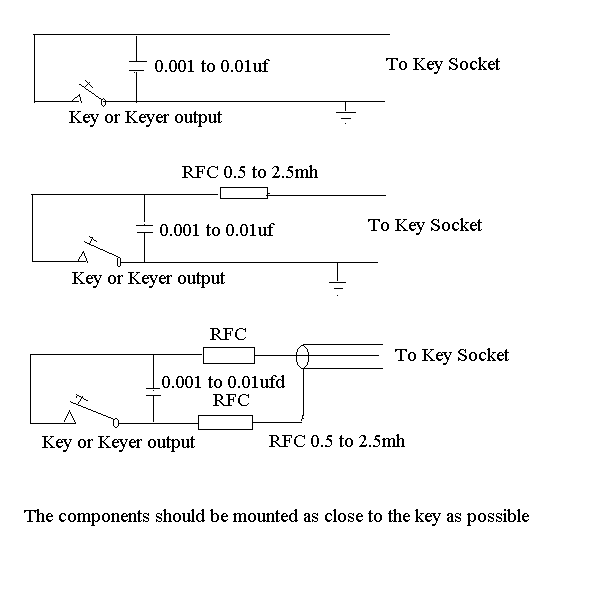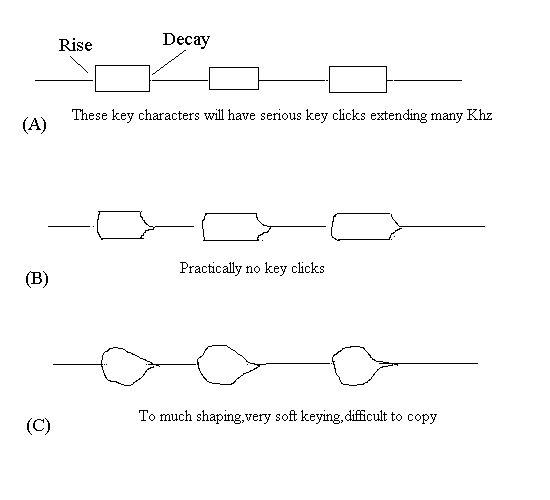Keyers and Keying Circuits
|
|
The Following Links are worth viewing for all cw enthusiasts |
| Zero Beating a CW Signal |
| Home Made Iambic Paddle Unit |
| Capacitance Toucher Paddle |
|
If you have a favourite circuit I will be pleased to put it’s details on this site. |
|
The following text was published in an
old (1960) copy of the ARRL Handbook:
|
|
The average operator finds that a speed
of 20 to 25 wpm is the limit of his ability with a straight hand key.
However, he can increase his speed to 30 or 40 wpm by the use of a speed
“key”. The mechanical speed keys,available in most *NOT
IN THE UK* radio stores, give additional speed by making strings of dots
when the key lever is pushed to the right; dashes are made manually by
closing the key to the left. After practicing with the “speed”
key, the operator obtains the correct *feel* for the key, which allows
him to release the dot lever at exactly the right time to make the required
number of dots.
A speed key can deliver practically perfect code characteristics when used by an operator who knows what good code should sound like; however, one will not compensate for an operator’s poor code ability. An electronic speed key will not compensate for an operator’s poor sending ability, either. However, the electronic speed key has the feature that it makes strings of both dots and dashes, by proper manipulation of the key lever, and in current designs the dashes are self completing. This means that it is impossible to send anything but the correct length of dash when the key lever is closed on the dash side. It is, of course, possible to send the incorrect number of dashes through poor operating timing |
R.F.CLICKS
When any circuit carrying d.c. or a.c. is closed or broken, the
small or large spark (depending upon the voltage and current) generates r.f.
during the instant of make or break. This r.f. covers a frequency range of many
Mhz. When a transmitter is keyed, the spark at the key (and relay, if used)
causes a click in the receiver. This click has no effect on the transmitted
signal. Since it occurs at the same time that a click (if any) appears on
the transmitter output, it must be removed if one is to listern critically to
his own signal within the shack. A small r.f. filter is required at the keyed
circuit . Typical circuits and values are shown in fig.1.
To check the effectiveness of the r.f. filter, listern on a lower frequency
band than the transmitter output frequency, with a short antenna and the gain
backed off.
Envelope Shapes
The key clicks that go out on the air with the signal are controlled by the
shape of the envelope of the signal. Fig.2. shows representitive scope pattern
that may be obtained with a given transmitter under various conditions.
One should understand that the on - the - airclicks are determined by
the shaping, while the r.f. clicks caused by the spark at the key can only be
heard in the station receiver and possibly a broadcast receiver in the same
house.
CHIRP
Chirp is caused by a change in frequency of the transmitted signal during a
single dot or dash.Chirp is an easy thing to detect if you know how to listen
for it, although it is amazing how some operators will listern to a signal and
say it has no chirp when it actually has. The easiest way to detect chirp is
to tune into the morse signal at a low beat tone and listen for any change in
frequency during the dash. The lower the beat note, the easier it is to detect
the frequency change. Listening to a harmonic of the signal will accentuate
the frequency change.
The main reason for minimizing chirp, is one of pride, since a properly shaped
chirp - free signal is a pleasure to copy and is likely to attract attention
by its rarity. chirps cannot be observed on an oscilloscope pattern of the envelope.
BACKWAVE
The last factor is "backwave", a signal during key-up conditions from some
amplified-keyed transmitters. Some operators listening in the shack to their
own signals and hearing a backwave think that the backwave can be heard on the
air. It isn't necessarily so, and the best way to check is with an amateur a
mile or more away. If he can't hear a backwave on the S9+ signal, you can be
sure that it isn't there when the signal is weaker. Backwave is undesirable
because it makes a signal harder to copy, even with acceptable shaping and no
chirp.

